Method of preparing an optical polymerizate
a polymerizate and optical technology, applied in the field of preparing a polymerizate, can solve the problems of not having the impact resistance required to be suitable for use as daily wear lenses for eyeglasses, thin lenses may negate any benefit, and cannot meet the requirements of eyeglasses. daily wear lenses cannot meet the requirements of impact resistance,
- Summary
- Abstract
- Description
- Claims
- Application Information
AI Technical Summary
Problems solved by technology
Method used
Image
Examples
example 1
[0080]Thioglycerol bis(2-mercaptoacetate) is a preferred polythiol monomer of the present invention, in which R1 and R2 are each methylene with reference to general formula I. Thioglycerol bis(2-mercaptoacetate) was prepared from the following ingredients.
[0081]
IngredientAmount (grams)Charge 13-mercapto-1,2-propanediol19952-mercaptoacetic acid2333methane sulfonic acid14.2Charge 2aqueous ammonia (a)4218(a) An aqueous solution of 5% by weight ammonia.
[0082]The ingredients of Charge 1 were added to a five liter round bottom flask equipped with a magnetic stirrer, a thermocouple and heating mantle coupled through a temperature feed-back control device, and a vacuum distillation column. A vacuum of from 5 to 10 millimeters (mm) of Hg was drawn and the reaction mixture was heated to and held at 70° C. for a period of 4 to 5 hours while water was collected from the distillation column.
[0083]When no more water was observed to be collected from the distillation column, the reaction mixture w...
examples 2 and 3
[0084]A polyisocyanate was mixed with a polythiol (Example 2) and also with a polyol (Example 3) at 80° C. for 2 hours to yield a viscous liquid prepolymer first component. The warm prepolymer first component was rapidly stirred and a diamine second component was added thereto. After the mixture stirred for several seconds, the mixture was immediately charged between two flat glass molds. The filled molds were heated to 120° C. and maintained at that temperature for 16 hours, yielding a plastic sheet. The polyisocyantes used in the examples were α,α′-xylene diisocyanante (XDI) and bis(isocyanatocyclohexyl)methane (H-MDI). The dithiol and polyols were 2,2′-thiodiethanethiol (DMDS) and Tone Polyol 32B8 (UC32B8), Tone Polyol obtained from Union Carbide Corporation, Danbury, Conn. The polyamine second component was diethyltoluenediamine (DETDA). The specific molar composition and molar ratio of each component used for each example are summarized in Table 1. Measured physical properties ...
example 4
[0085]A first component was prepared by mixing 0.6 equivalents of H-MDI with 1 equivalent of DMDS at 90° C. for an hour. While stirring, 0.6 equivalents of XDI were added to the first component. The mixture was allowed to stir for an additional 1.5 hours to yield the viscous prepolymer. 0.25 equivalents of DETDA were added to the warm prepolymer. After stirring for several seconds, the resulting mixture was charged between two flat glass molds. The filled molds were heated to 120° C. and maintained at that temperature for 16 hours, yielding a plastic sheet.
[0086]
TABLE 1NCO / ExampleNotebook—NCO—SH + —OH(SH +NH2 / No.No.compositioncomposition(OH)NCO28247-118TMXDIDMDS1.20.9538247-112XDI75% DMDS1.20.9525% UC32B848247-12350% XDIDMDS1.20.2550% H-MDI
[0087]
TABLE 2ExampleNDNDAbbeAbbeBarcol 934No.(AR1)(PLM2)(AR1)(PLM2)(0–15 sec)21.6041.6043332 to 3841–393—1.600—30 to 51—41.610—35—37–341measured using a B&L Abbe refractometer (AR)2measured using a polarized light microscope (PLM)
[0088]The example...
PUM
| Property | Measurement | Unit |
|---|---|---|
| Temperature | aaaaa | aaaaa |
| Time | aaaaa | aaaaa |
| Percent by mass | aaaaa | aaaaa |
Abstract
Description
Claims
Application Information
 Login to View More
Login to View More - R&D
- Intellectual Property
- Life Sciences
- Materials
- Tech Scout
- Unparalleled Data Quality
- Higher Quality Content
- 60% Fewer Hallucinations
Browse by: Latest US Patents, China's latest patents, Technical Efficacy Thesaurus, Application Domain, Technology Topic, Popular Technical Reports.
© 2025 PatSnap. All rights reserved.Legal|Privacy policy|Modern Slavery Act Transparency Statement|Sitemap|About US| Contact US: help@patsnap.com



